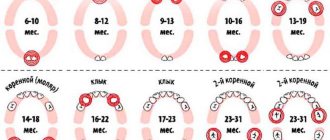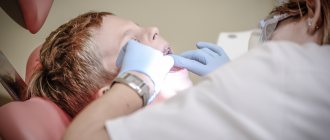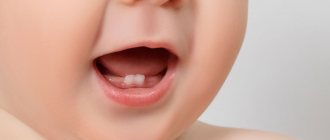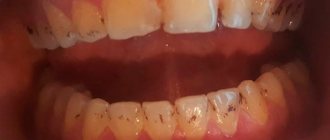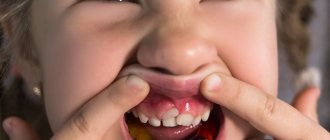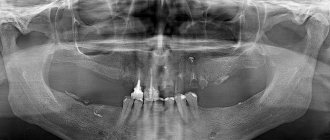When do the first teeth appear?
It is widely believed that a baby's first teeth should appear at six months.
If a child is 8 months old and has no teeth, parents begin to worry. Baby teeth begin to form in utero long before they become visible. Their rudiments appear already in the sixth week after fertilization. Over the next months, gradually, layer by layer, they are covered with hard enamel. A newborn's baby teeth are already formed.
A little later, roots begin to form. As they grow, they slowly push out the top of the tooth, which breaks through the gum. It happens that everything happens so quickly that the child is born with one or two teeth.
Newborn with teeth
The norm of the appearance of the first teeth
Usually, parents begin to look into the baby's mouth in search of the long-awaited tooth when he is 6 months old. Many of them soon find what they are looking for there. The rest patiently continue to carry out daily inspections. When a child turns 7 months old and still has no teeth, this is not a reason to worry. Most parents know this and therefore remain calm.
But when a baby doesn’t have a single tooth at 8 months, there is slight anxiety in the family. After all, everyone knows that from six to the beginning of the ninth month the incisor should appear. But should you? In fact, these norms are based on average statistics and are not a rule. There are cases when children are already born with several teeth, and it happens that the baby’s first incisor pecks only in the 9th or even 12th month of his extrauterine life.
Additional Information. In general, pediatricians advise parents not to panic if a long-awaited event drags on for up to 1.5 or even 2 years. Of course, provided that the rest of the baby develops normally.
Timing of the eruption process
There are average periods for the appearance of teeth, which are the norm.
Important! Each child is individual. It will be normal for a 4-month-old baby to erupt the first teeth and for a 10-month-old baby too.
Average terms:
- At birth, teeth are not visible. They are partially formed, but are located inside the gum;
- The first teeth appear on average between the fourth and seventh months (most often around 6 months of age). First, 4 central incisors emerge, two each below and above;
- At approximately seven or eight months, the 4 lateral incisors emerge;
- When a child is about a year old, his first 4 molars begin to grow. This leaves free space between them and the lateral incisors;
- This space contains 4 canines, which usually emerge at approximately 1 year and 4 months;
- At about 2 years of age, the second molars begin to grow;
- At the age of 3 years, a child should have all 20 baby teeth.
Teething pattern
Important! In children with late teething, they can all come out almost simultaneously.
Number of teeth at 8 months of age
For most children, the appearance of their first tooth becomes a pleasant surprise at the age of six months. Sometimes both lower incisors are shown at once. The upper central incisors erupt next. By the age of 8 months, the baby’s mouth is usually decorated with 4 teeth. And by one year – 8-12 teeth. All milk, namely 20 units, should appear by 3 years.
This is interesting: List of drugs to treat thrush in the mouth of a baby
Over 1 year old
At one year of age, children, as a rule, already have eight full milk teeth in their mouths. This age limit is the optimal time to visit the dentist. The doctor will evaluate the condition of the oral cavity and help prevent problems.
At the age of 1.5-2 years, a child can have from 4 to 14 teeth. We must begin to accustom him to oral hygiene, showing him how cleaning is done by example. By the age of 2.5 years, children, as a rule, acquire two dozen milk teeth, which serve them until the age of 5-6 years. A visit to the dentist or orthodontist may be necessary if:
- premature development of the jaws, which is facilitated by endocrine dysfunction;
- growth retardation, often caused by rickets, digestive problems, infections and genetic inheritance;
- incorrect position of the incisors, indicating deeper bone disorders.
Until the age of six, the number of teeth remains the same - about 20. At this time, you need to continue to develop in the child a love of oral hygiene, wean him from finger sucking and nail biting.
The first replacement of baby teeth with molars begins at 6-8 years of age. By the age of 14-15, the jaws are completely renewed.
Why does a child have no teeth for a long time?
When answering the question why a child has no teeth at 8 months, it is worth paying attention to the fact that boys’ teeth begin to erupt somewhat later than girls’. Heredity also plays an important role. Ask your parents; it is quite possible that they or you yourself started to get your first teeth quite late. In this case, there is absolutely no reason to worry. You just need to wait a little.
The appearance of the first teeth in children is a purely individual process and depends on a number of factors - heredity, previous diseases, the diet of the baby and the nursing mother.
There are several reasons for prolonged absence of teeth:
- genetic diseases;
- any disturbances in the functioning of the endocrine system;
- lack of vitamin D in the baby’s body (rickets);
- absence of tooth buds in the baby due to diseases suffered by the mother during pregnancy.
If you are very concerned about the fact that your child has not yet developed his first teeth at 8 months, go to the dentist. The doctor will determine the exact cause of missing teeth and determine whether your child’s development is normal. If necessary, the dentist will give you a direction to take a picture of the jaws, which will clearly show whether the child has the rudiments of teeth.
Very slow teeth growth, irregular shape or strange color should be the reason for an urgent visit to the dentist. Only a doctor can determine the true cause and prescribe the necessary treatment.
What deviations from the norm are acceptable?
If you take 6 months as the average age for teeth to appear, then you can safely wait another six months for this event.
Important! If by the age of one year the baby’s teeth have not yet come out, then it is better to contact a pediatric dentist.
Violations in the sequence of teeth coming out are also considered normal. If two incisors emerge from below, and then one tooth from above, then the second upper incisor may emerge after the appearance of the lower lateral incisors. That is, there will already be four teeth on the bottom, and the second one will just begin to emerge from the top.
The general rule is that the bottom teeth appear slightly earlier than the top teeth. But why panic if the top teeth come through first? This is also a variant of the norm.
Deviations in the order of eruption
Important! Late teething has its benefits. If they appear later, it means that the enamel will be better mineralized, since the main mineralization occurs when the tooth is still inside the gum.
Pathological causes
Pathologies in the formation of fetal teeth are very rare (in less than 1% of infants), but they do exist. This happens when the rudiments of teeth dissolve or do not even form in the child’s body. There are several types of pathologies:
- Hypodontia is the absence of up to six teeth. It can be congenital and subsequently developed;
- Anodontia – complete absence of teeth;
- Oligodontia is the absence of more than 6 teeth. It has an innate character.
Among the factors determining pathology, the main one is genetic. Other reasons:
- injury or infection during tooth development;
- gland dysfunction;
- rickets;
- measles during pregnancy;
- serious intrauterine disorders.
Reasons why there may be more teeth than normal at 8 months
There is another problem - parents think there are too many teeth. That is, a child at 8 months has grown more than 8 teeth. Is this really a pathology, and should parents worry?
There is no need to panic. When the first teeth appear after 3 months, this is an indicator of the norm. This happens if the expectant mother constantly takes prenatal vitamins or drinks them while breastfeeding. This is also possible in bottle-fed children. This means that the child’s body has enough microelements and essential substances.
This is interesting: How many baby teeth normally erupt at 2 years of age?
It’s another matter when the first incisors appeared before 3 months of age. In this case, there is reason to suspect diseases of the endocrine system. You need to show your baby to a doctor and undergo an examination.
Examination and treatment
If a child has no teeth at 10–12 months, the pediatrician may prescribe an examination to determine the reasons for the delay. A panoramic x-ray shows whether there are baby tooth buds in the child's jaw. In case of partial edentia, specific treatment is prescribed to allow the embryos of permanent teeth to develop correctly. To ensure that the jaw is formed correctly and food is chewed efficiently, special removable dentures are made to compensate for missing baby teeth for a 3-year-old child.
The doctor may prescribe an ultrasound scan of the abdominal organs, blood tests, stool tests, urine tests of the child and others, if necessary. Vitamins and minerals are prescribed to strengthen the immune system, primarily vitamin D and calcium. The child should spend as much time as possible outdoors. He is given ring toys as a stimulant. A light massage of the gums with a clean finger is helpful.
Parents should be alerted if the incisors erupt too early, before 3 months. In some cases, this may indicate disorders in the endocrine system, but more often than not, early teething in children is an individual feature.
Before appearing from the outside, the incisor passes through the bone tissue surrounding it, and then through the mucous membrane of the gums. Do I need help with teething? Trying to speed up the process of its appearance with a piece of sugar, a spoon or other objects, you can damage the gums and introduce an infection into it.
According to a good ancient tradition, the one who discovers the child’s first tooth gives him a silver spoon. It is believed that she will bring him health and wealth. She can lightly tap the tooth and make sure that it has erupted and all anxious expectations are left behind.
When should you see a doctor?
Teething causes a lot of discomfort for the baby. This does not require medical attention. But there are situations when you cannot do without the help of a doctor. You should contact him in the following cases:
- Painful cough.
- The temperature does not subside for a long time.
- There is mucus and blood in the stool.
- Diarrhea
- and purulent nasal discharge.
- Constipation.
- Mouth ulcers.
- Unnatural color of the shoots.
Symptoms from teething hide the manifestation of diseases, for example, ARVI or infectious diseases. It is important to consult a doctor if negative symptoms occur. Exercise caution in such cases rather than regret later what you didn’t do.
How a dentist can help
If you are not ready to wait a year, seek help from a good pediatric dentist. The specialist will take an X-ray of the jaw to ensure the presence of tooth buds. If everything is fine, all you have to do is calmly wait for the process to begin - gum enlargement and increased salivation. Now it's time to help the baby:
- a ring stimulator will moderate itching, reduce discomfort and speed up teething;
- You can gently massage your child’s gums with a clean finger or a small spoon;
- stimulates tooth growth and fortified complementary foods - healthy juices and purees. While there are no teeth, solid complementary foods cannot be introduced.
This is interesting: Aphthous stomatitis in children: signs, causes and methods of treatment
If your health is fine
The timing of eruption depends on heredity, including grandparents, and on external factors. It is believed that in hot climates, teeth appear earlier, as early as 4 months. When a child is healthy and his development corresponds to his age, but there are still no teeth, although they should already appear in accordance with average standards, this causes concern among parents. Modern doctors indicate only approximate dates for the sequence of growth of the first teeth. The standard teething pattern looks like this: from 5–6 months - on each jaw there are 2 central incisors (first from below, then from above), from 8 months - lateral incisors, by the year the child has only 8 teeth. They are known to appear in pairs and alternately on both sides.
What to do if a child has only grown one tooth and there are no signs of a second one? You need to know that the sequence of teething may be different and this is not considered an anomaly. There are many options for their appearance. At seven months they can erupt 2 - from below, then 1 - from above, then the third and fourth - in the bottom row, and only after them the missing top one.
Many mothers tend to associate the whims of a 3-4 month old child, poor sleep or appetite with the imminent appearance of the first incisors. There is no doubt left if the baby also puts everything into his mouth and drools profusely. Sometimes it seems to mothers that the gums are already red; they look into the child’s mouth in the hope of seeing that swollen white ball from which the long-awaited tooth is about to emerge. But days and weeks pass, the child is already 7 months old, and there are no teeth? No need to panic.
If the baby’s health is fine, you just need to wait, especially since all the dates are individual and there may be deviations in one direction or another for six months. Some children have their first incisors at 4 months, while other babies can already walk by the time they begin to emerge.
Parents' actions
Why did a newborn baby vomit blood during feeding - reasons
Parents should be wary only if their baby is completely missing teeth by the age of one. If there are simply few of them, then these are the individual characteristics of the child.
After a consultation with a pediatrician, tests can be performed and, if necessary, an x-ray of the baby’s jaw to determine the reasons for the delay in teething. If there are no abnormal processes or congenital pathologies, then you just need to wait.
In some cases, your doctor may recommend taking vitamin D. However, parents should not decide on their own how to take it.
Teething in most cases is accompanied by general and local symptoms, which can be more or less irritating for the baby. Overall, these are minor and temporary disruptions. The most common are:
- swollen and inflamed gums;
- excessive salivation;
- excitability;
- disturbed sleep;
- in some cases, lack of appetite, fever, diarrhea.
At 7 months of age, it is still too early to worry and you should not take any action to speed up teething. However, you can help your baby ease this process if his teeth are about to come out:
For your information. All activities must be done in compliance with the necessary hygiene.
- When a child puts everything that comes into his hands into his mouth, it is necessary to prepare a special children's toy or rubber rings. They massage the gums and stimulate teeth to come out. In addition to toys, you can give your baby pieces of fruit or vegetables, but they should be large enough to prevent part of the fruit from getting into the throat;
Baby with teething ring
- Cold eases the itching and pain of teething, so before giving it to your baby, you can put the toy or rings in the refrigerator (but not in the freezer!);
- You can massage your gums with your hands, placing sterile gauze soaked in cold water on them;
- Anti-inflammatory and analgesic teas (sage, chamomile) are very effective in combating gum pain. They are sold at the pharmacy. You need to give your child tea from a spoon; you can apply it to the gums with a cotton swab;
- If your baby is drooling a lot, it is best to wear a bib during the day. The skin around the mouth must be kept dry, otherwise redness and irritation will appear.
Parents must be patient and remember that each child is different. For him, there are only his own timing and order of teething, which may differ even from the timing of his siblings. Not all children cut their teeth according to average patterns, just as not all of them suffer when the first tooth comes out.
Prevention of pathologies of eruption of baby teeth in children
It is impossible to control or influence such processes.
Dental buds are formed even before the baby is born, so after his birth it is difficult to change anything. During pregnancy, a woman should monitor her health, in case of illness, immediately consult a doctor, not self-medicate and not advance the disease. It is important to take vitamins, as they have a beneficial effect on the condition of the expectant mother and child.
After birth, parents are obliged to monitor the baby’s condition - take care of his health, provide complete and proper nutrition. This will affect not only the condition of the teeth, but also the overall development of the child.
Recommendations for avoiding delay
- After tooth loss, you should not eat or drink hot drinks for several hours.
- The plug that forms in the hole cannot be removed to avoid infection. It will disappear on its own.
- It is not advisable to eat solid food for the first time after the loss.
- If you experience pain, redness, swelling or other signs of exacerbation, you should immediately contact your dentist. Remember, our specialists are always ready to help and answer your questions by phone.
The most popular myths about teething
Myth 1. If teeth erupt after 10-11 months, this indicates a developmental delay.
In fact, this is only an individual characteristic of the body or a hereditary predisposition. In most cases, it is completely unrelated to the level of general development of the baby.
Myth 2. The later the first baby incisors come out, the healthier the teeth will be.
Dentists claim that there is no such connection between timing and quality. This is also purely individual.
Myth 3. Special medications can help teeth erupt.
There are no medications that would speed up this process. Only mechanical stimulation can help teeth, but even this procedure can be carried out in consultation with the dentist.
So what to do if a child has no teeth at 8 months? Do not panic. Most likely, nothing bad is happening. If the pediatrician has no questions for your baby, the child is gaining weight well, is developing according to his age and is behaving normally, then you will have to be patient and wait a little longer. Very soon the gums will signal that they are ready to please you with your first baby incisors. If you still have doubts, you can make an appointment with a pediatric dentist you trust.
Sources
- https://kpoxa.info/zdorovie-pitanie/rebenku-7-mes-net-zubov.html
- https://NashyZubki.ru/detskie-zubki/u-rebenka-v-7-8-9-mesyatsev-net-zubov-prichiny.html
- https://stomatolab.com/kids/rebenku-8-mesyacev-net-zubov.html
- https://ymadam.net/deti/zdorov-e-rebenka/zuby-u-rebenka-v-8-mesyatsev.php
- https://MikDent.ru/rebenok/prorezyvanie/rebenku-8-mesyacev-zubov.html
- https://stomatology.su/pochemu-u-rebenka-v-8-mesyacev-net-zubov.html
- https://zubi.pro/detskaya/net-zubov-v-7-mesyatsev.html
- https://za-rozhdenie.ru/stomatologiya/normalno-li-chto-u-rebyonka-v-7-mesyaczev-net-zubov

